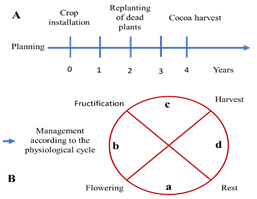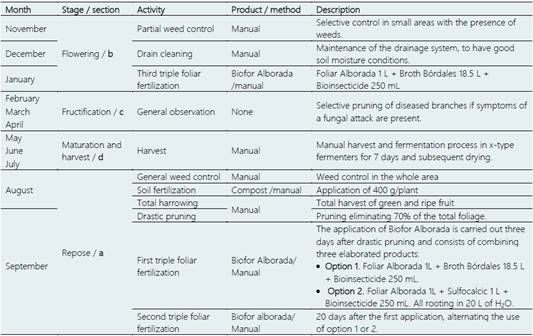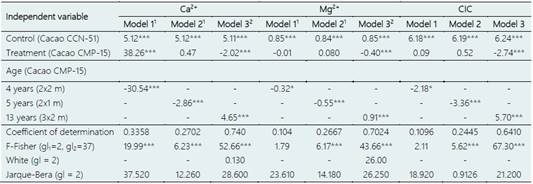1. Introduction
Cacao is the second most important crop in the Leoncio Prado province, which is the leading producer in the Huánuco region. The Ministry of Agrarian Development and Irrigation - MIDAGRI (2021), reports a record figure of 151.6 thousand tons in 2020, with Huánuco contributing 13 thousand tons, equivalent to 8.56% of national production. In addition, it is important to highlight the growth of production, the Huánuco region ranks second with an average annual rate of 24.7% in the last ten years.
The national production of cacao beans has been increasing for ten years and is growing at an average annual rate of 12.6%, however, 53.3% corresponds to the Trinitario group, whose most widespread variety is CCN-51, a high-yielding, early and disease-resistant species, despite this goodness, the yield is still deficient, 840 kg/ha (MIDAGRI, 2021) compared to countries with higher yields in the world (2.5 to 3 t/ha) for Thailand and Guatemala (Florida et al., 2020) and in Latin America 0.45 t/ha for Colombia (Montealegre et al., 2021) and 0.42 t/ha for Ecuador (Ministerio de Agricultura y Ganaderia-MAG, 2022). The low yields are likely due to the application of conventional systems and the genotype of cacao grown, which may be affecting productivity and the agroecosystem (Torres et al., 2006).
Agricultural practices such as monoculture, mechanization and the use of agrochemicals degrade soil structure and lead to changes in the productive potential of the soil. (Navarro et al., 2019, Florida & Acuña, 2020). Therefore, conservation tillage is viable alternative that produce changes that improve soil properties in the long term (Garcia et al., 2018). In cocoa production, organic management is a viable alternative because, when properly developed, it provides yields similar to those of conventional management systems (Florida et al., 2020). In addition, it can be applied in agroforestry systems (AFS), the latter, bring additional benefits in cacao production (Guzman & Levy, 2009), understanding that AFS includes a set of land management techniques to combine crops and forest species that contribute to the sustainability of the system through litter production, nutrient recycling, and prevention of soil erosion (Sánchez et al., 2016). In addition, PBS reduce the amount of radiation that benefits cocoa and produce wood that can complement production, therefore, proper shade management in cocoa is necessary for light regulation, plant nutritional status (Alvarez et al., 2012), reduce CO2 emissions more effectively by increasing forest area (Zavala et al., 2018) and maintain the balance of agroecosystems (van-Vliet and Giller, 2017).
Organic management responds to many factors such as the local reality, the producer's knowledge, and the application of techniques such as the use of compost (Florida et al., 2020), efficient microorganisms and biofertilizers (Ramirez et al., 2019), pruning work (Rojas et al., 2021, López et al., 2016) and genotype selection (Sánchez et al., 2015), each of them shown to have benefits in the production and conservation of the agroecosystem. In this context, the "Alborada" farm has been applying a technology based on the organic management of an agroforestry system between T. cacao L (cacao) and Guazuma crinita Mart. (Bolaina blanca), the technology is called "Méndiz Organic Management (MOM)" based on the integration and improvement of the techniques already mentioned: a) the annual drastic pruning of the plantation, b) the application of compost and foliar biofertilizer, based on local inputs, according to the phenological stage of cacao, c) use of the cacao variety CMP-15 (Méndiz Paredes Collection 15) and, d) application of high planting density. Therefore, the research evaluates, through modeling as a statistical tool, to validate and measure the impact of MOM technology on soil quality with CMP-15 cacao plantations, under agroforestry system developed in the Alborada farm, Leoncio Prado province, Huánuco region - Peru.
2. Materials and methods
2.1 Study area
The research was carried out at Fundo Alborada, owned by Ing. Mendis Paredes Arce. It is located in the jurisdiction of Castillo Grande (9°16′41″S and 76°00′31″W); it belongs politically to the province of Leoncio Prado, Huánuco-Peru region. It presents two humidity regimes, a rainy one from December to May and a dry one from June to November, the general climatic conditions are as follows: average annual temperature is 24.5 ºC, relative humidity of 84%, and annual precipitation of 3400 mm. According to Pulgar (2014), the area belongs to the Rupa Rupa or high rainforest ecoregion.
2.2 Cacao plantations
The research identified cacao areas CMP-15 (Mendis Paredes Collection-15) and CCN-51 (Castro Naranjal Collection-51), in agroforestry system with Guazuma crinita Mart. (Bolaina Blanca). The areas of CMP-15 selected are three: the first has a planting spacing of 2x2 m, 4 years of installation, and an average yield of 2.7 t/ha, the second of 2x1 m, 5 years of installation and a yield of 3.5 t/ha, the third of 3x2 m, 13 years of installation and an average yield of 3.3 t/ha. Also, CCN-51 was evaluated in an area of 2x2 m and 10 years of installation with an average yield of 1 t/ha; the latter was considered as the reference treatment because it is the most widespread variety in the region.
2.3 MOM management in the evaluated areas
The Alborada farm applies the technology called "Mendis Organic Management (MOM)" in honor of its owner, Mr. Mendis Paredes Arce. MOM management consists of the chronological, sequential, and integral application of a set of techniques according to the physiological cycle of the plant, including annual drastic pruning of the plantation, application of compost and foliar biofertilizer based on local inputs, and use of the CMP-15 cacao variety with high planting density. The management of this technological package is subdivided into two stages:
The first stage (Figure 1A) explains the process of installing cacao cultivation in all the areas evaluated: the first year starts with a slash and burn of the forest and planting of cacao, the second-year grafting, dead plants are replaced, and pruning is carried out for plant formation. In this stage, MOM management is partially applied from the first to the third year of crop installation, excluding drastic pruning.
The second stage (Figure 1B) explains the application of OM management according to the physiological cycle of the plant, it is applied 100% from the third year, that is, in the productive stage of the crop.
Table 1 summarizes chronologically and according to the physiological cycle of the plant the application of MOM, by sections a, b, c and d shown in Figure 1B. The application of the technology starts with:
Reset section (a), the resting stage that prepares the soil and the plant for the next harvest. It occurs between August and October, the end of the harvest, the first weed control and composting of the soil is carried out, followed by heavy pruning. In addition, this stage culminates with the application of Biofor Alborada, a foliar biofertilizer composed of three products whose composition and preparation are detailed below:
a) Foliar Alborada, consists of the mixture of a mixed infusion and the combination with different manures. The mixed infusion consists of leguminous leaf 5 kg, Carica papaya leaf 3 kg, Equisetum arvense leaf 3 kg, and Urtica dioica leaf 5 kg, all this, boil in 30 L of H2O for 30 minutes. The infusion is mixed with bovine manure 10 kg, goat manure 5 kg, guinea pig manure 3 kg, bat manure 3 kg, alborada compost 3 kg, and ash 3 kg. The mixture is placed in a 200 L cylinder and rooted to 150 L with water, move daily for 30 days, then sieve before use.
b) Cupric solution, in this case, there are two alternative products, the first one is the Caldo bordales, which consists of mixing: 1kg CaO in 90 L of water, to this, add 1 Kg CuSO4 dissolved in 10 L of water. The second option is the Sulfocalcic, which is prepared by mixing: 1 kg CaO + 1 kg of Sulfur, rooting in 20 L of water, and boiling until it turns to a wine color.
c) Natural insecticide, prepared with 3 kg root of Lonchocarpus sp, 1 kg of Capsicum pubescens, 1 kg of Allium cepa 0.5 kg of Allium sativum. Blend in 10 L water and let stand for 10 days. Filter before applying.
Flowering section (b), the flowering stage, takes place between November and January, the plant at this stage should not be intervened, therefore, monitoring and selective control of parts infested by diseases are performed. In the end, the third application of Biofor Alborada is made to favor the next stage, fruit formation.
Fructification and harvest section (c and d), fruiting and harvesting stages, take place between February and July. The first quarter of these two stages consists of supervising the plantation and extracting fruits infested by fungi to prevent their proliferation. The last stage (d), between May and July, is the harvesting of the plantation, the residues are deposited in defined spaces for composting and reuse.
2.4 Soil analysis
Samples were taken in March 2022 and the physical indicators evaluated were texture and resistance to root penetration (Rp), using the Bouyoucos hydrometer method for texture and the direct method through a cone penetrometer for Rp. The chemical indicators evaluated were pH, determined by the electrometric method in distilled water with a 1:2.5 ratio. Ca2+, Mg2+ and K+ were extracted with ammonium acetate at pH 7 and determined by atomic absorption. Available P content by modified Olsen extracted with NaHCO3 0.5 mol/L solution at pH 8.5 and determined by colorimetry. MO content was determined by Walkley & Black method and CEC was determined by saturation by ammonium acetate (CH3COOH) at pH 7, protocols are described in Bazán (2017).
2.5 Statistical analysis
The work was statistically adjusted to the completely randomized design (CRD). The treatments were CCN-51 areas of 2x2 m and 10 years of management (MOM1), CMP-15 areas of 2x2 m and 4 years of installation (MOM2), 2x1 m and 5 years of installation (MOM3) and 3x2 m, 13 years of installation (MOM4), with sample size n= 40 (10 samples per treatment). The data were subjected to analysis of variance and Tukey's post-hoc test (p < 0.05) for the comparison of means between treatments, the principal component analysis (PCA) was able to determine the relevant soil quality indicators by a factor using the varimax method, being these the basis for the analysis of multiple linear regression models as the impact of time, variety, and planting density. IBM-SPSS 25 software was used for the analysis of variance and Stata 15.0 for the PCA and modeling.
The multivariate model was:
Yi represents each of the physical and chemical indicators of the soil, β2 represents the effect of the control variable, β 3 represents the effect of the treatment variable, and β 4 represents the impact of the Agej variable. Due to the presence of multicollinearity in its perfect mode between the control variable and the independent term, we proceeded to eliminate the parameter β 1 from equation (1), remaining as:
Where: (for the case of Age1 represents 4 years, Age2 represents 5 years and Age3 represents 13 years) and μ i is the stochastic component, for all i = 1, 2, 3, ..., n data. The values of β 2 , β 3 and β 4 of equation (2) are estimated by the ordinary least squares (OLS) method, if heteroscedasticity is present in the stochastic component, the βs will be estimated by generalized least squares (GLS), to obtain homoscedasticity
3. Results and discussion
3.1 Soil physicochemical indicators
Table 2 shows the mean, standard deviation, and statistical significance between treatments for each indicator evaluated. Texture and Rp as physical indicators show differences p < 0.01 in all fractions (sand, silt, and clay), as well as Rp, the latter showing a significant increase with time of management, the highest values being those of CCN-51 with 10 and CMP-15 with 13 years of MOM management.
The results were obtained in cacao areas CMP-15 (Mendis Paredes Collection-15) and CCN-51 (Castro Naranjal Collection-51) in an agroforestry system with Guazuma crinita Mart. (Bolaina blanca) present textures Franca and soft Rp (FAO, 2009) with values between 1.18 to 1.46 kg/cm2, in all cases differences p < 0.01 are observed (Table 2). In the case of Rp, regardless of the variety and planting density, the highest values are presented by CCN-51 with 10 years and CMP-15 with 13 years of organic management (MOM1 and MOM4), showing a tendency to increase over time, although it cannot be said that there is a process of soil compaction, showing positive effects of MOM management applied in comparison to that reported by Celis et al. (2020), in cacao with conventional management of 12 years found averages of 2.16 kg/cm2 in soil with the same textural class in Padre Abad, Ucayali region.
In general, the result can be explained by taking into account that texture has a direct relationship with bulk density, porosity, water retention, aeration, drainage and OM content of the soil (FAO, 2009, Camacho et al., 2017), in addition, the sand fraction is chemically inert and lack colloidal properties (FAO, 2009), on the contrary, clay is the active fraction of the soil, determining to a large extent soil CEC and cation retention capacity (Navarro & Navarro, 2003), finally, changes due to spatial variability between evaluated areas cannot be ruled out (Pascual et al., 2017; Florida & Acuña, 2020). All these considerations would explain the differences shown by sand, silt and clay and evidence that the MOM management of cocoa in agroforestry system in 13 years has not produced relevant changes that jeopardize the physical quality of the soil.
The indicators pH, OM, N, P, K+, Ca2+, Mg2+ and CEC were evaluated, indicators usually used to identify changes in soil quality (Garcia et al., 2012, Estrada, 2017); being clas sified according to FAO (2009) as levels between slightly acid to neutral in pH, low to medium in OM, N, P, K+, Ca2+, Mg2+ and low to very low in CEC. These are normal values in tropical and subtropical soils with high rainfall (Navarro & Navarro, 2003). In addition, all the indicators evaluated show differences, however, only Ca2+, Mg2+ and OM changed levels and increases over time were observed for pH, OM, N, P, Ca2+, Ma2+ and CEC, with the highest averages corresponding to the CMP15 plantation of 13 years of management, this due to the incorporation of compost and the work of efficient microorganisms that accelerate the decomposition of organic residues.
Table 2 Effect of MOM management on soil physical and chemical indicators
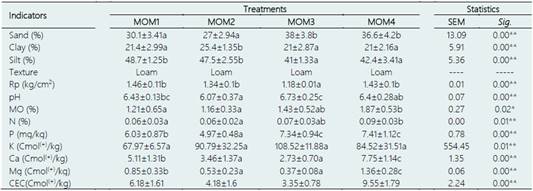
Mean values ± standard deviation (n = 10); MOM1 CCN-51 area 2x2 m and 10 years of management; MOM2 CMP-15 areas 2x2 m and 4 years of management; MOM3 CMP-15 area 2x1 m and 5 years of management; MOM4 CMP-15 area 3 x 2 m and 13 years of management. Different letters indicate significant differences at p<0.05, * significant at p<0.05, and ** significant at p < 0.01.
3.2 Principal component analysis (PCA) and modelling
The null hypothesis in Bartlett's test of sphericity states that there is no correlation between the soil physicochemical indicators. The Chi-square test with 66 degrees of freedom rejects this hypothesis (p < 0.01) obtaining 0.00 in the determinant of the correlation matrix, the latter, determines the existence of a linear correspondence between the indicators (Table 3). In addition, the KMO adequacy measure with 62% supports the use of the PCA to identify relevant indicators for modelling and recommends taking the first four factors as the point of analysis because they have eigenvalues greater than unity. Rotated by the varimax method, Factor 1 has an eigenvalue of 3.31 and manages to explain 27.59% of the total variance, Factor 2 of 3.26 and 27.17%, Factor 3 of 2.19 and 18.27%, and Factor 4 of 1.54% and 12.85%. The relevant indicators with factor loadings greater than 0.75 are: Ca2+, Mg2+ and CEC in Factor 1, Sand and Clay in Factor 2, OM and N in Factor 3 and K+ in Factor 4.
Table 3 Bartlett's test and KMO, according to physical and chemical indicators of the soil in cocoa production at Fundo la Alborada
| Statistical indicator | Value |
|---|---|
| Bartlett's sphericity (gl=66) | 776.150*** |
| Adequacy measure KMO | 0.62 |
| Correlation matrix determinant | 0.000 |
***p < 0.01, **p < 0.05 y *p < 0.10, gl = Degrees of freedom KMO = Kaiser-Meyer-Olkin.
3.2.1 Modelling for Ca2+, Mg2+ and CIC of Factor 1
Table 4 explains that in the F-Fisher test, the control variable, treatment, and age, as appropriate, jointly influence (p < 0.01) Ca2+ (Model 1, 2 and 3), Mg2+ (Model 2 and 3), and CEC (Model 1, 2 and 3). The Jarque-Bera test shows that the stochastic components fit a normal distribution function, and the White test supports that the variance of these components is homoscedastic.
The impact on Ca2+ content at ages 4 and 5 years is negative with 30.54 and 2.86 Cmol(+)/kg in Model 1 and 2 and positive for age 13 years with 4.65 Cmol(+)/kg in Model 3. In Mg2+, the impact of age 4 and 5 years is negative at 0.32 and 0.55 Cmol(+)/kg on Mg2+ with the p < 0.05 and 0.01 level for Model 1 and 2, this impact is positive at age 13 years of 0.91 Cmol(+)/kg with the p < 0.01 level. As for CEC, the impact of ages 4 and 5 years is negative 2.18 and 3.36 Cmol(+)/kg with the level of p < 0.05 and p < 0.01; while, for age 13 years it is positive 5.70 Cmol(+)/kg at p < 0.01.
3.2.2 Modelling for sand and clay of Factor 2
Table 5 explains that in the F-Fisher test, the control variable, treatment, and age jointly influence (p < 0.01) the sand fraction (Model 1, 2 and 3) and the clay fraction (Model 1). The Jarque-Bera test shows that the stochastic components conform to a normal distribution function, and the White test determines that the variance of these components is homoscedastic.
The impact is negative at the p < 0.01 level on the sand fraction at age 4 years and positive at age 5 years, concerning age 13 years, it has a positive impact on the % of the sand fraction at p < 0.05. Likewise, the control variable has a significant (p < 0.01) consequence on the % sand for the three models. Regarding clay, the control variable (p < 0. 01) manages to explain the clay content for the three models; while the age of 4 years has a positive impact at the p < 0.01 level, the age of 5 years manages to impact negatively by 2.20% at the p < 0.05 level. Finally, the PCA determined the sand and clay fraction relevant in Factor 2, excluding the silt fraction and Rp because they did not have a significant influence on the total variance.
3.2.3 Modelling for MO and N of Factor 3
Table 6 explains that in the F-Fisher test, the control variable, treatment, and age jointly influence (p < 0.05) the OM content (Model 1 and 3) and the N content (Model 2). The Jarque-Bera test shows that the stochastic components conform to a normal distribution function, and the White test determines that the variance of these components is homoscedastic. Regarding the impact, age 4 years of planting is negative by 0.49% on OM content at the p < 0.05 significance level and age 13 years impact positively by 0.58% on OM content at the p < 0.01 level. Likewise, the impact of age 4 years is negative 0.028% on N content and age 13 years is positive 0.031%. The control variable is the only determinant at the p < 0.01 level on N content for Model 2.
1: Parameter estimation by Generalized Least Squares (GLS), 2: Parameter estimation by Ordinary Least Squares (OLS), gl1: numerator degrees of freedom, gl2: denominator degrees of freedom, gl: degrees of freedom, *** p < 0.01, ** p < 0.05 and * p < 0.10.
Table 5 Multiple linear regression of sand and clay using the GLS and OLS methods
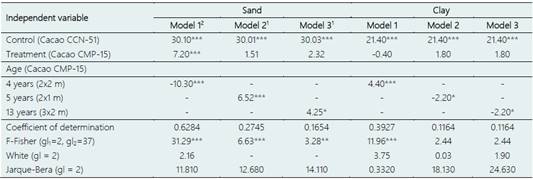
1: Parameter estimation by Generalized Least Squares (GLS), 2: Parameter estimation by Ordinary Least Squares (OLS), gl1: numerator degrees of freedom, gl2: denominator degrees of freedom, gl: degrees of freedom, *** p < 0.01, ** p < 0.05 and * p < 0.10.
3.2.4 Modelling for K+ of Factor 4
The regression for K+ (Table 7), shows that the impact of Age 4 years is negative at 30.5 mg/kg and positive at 0.24 mg/kg on the K+ content in Model 1 and 2 with the p < 0.01 and 0.05 level of significance respectively; while, for Model 3 no significant impact is shown, in addition, the control variable and treatment shown to be influential in explaining the K+ content for the three models. Together, the variables shown to be influential on the K+ content according to the F-Fisher test at the p < 0.01 and 0.05 level of significance, in terms of variation, they explain 33.58%, 33.13% and 22.82% according to the coefficient of determination. Finally, the stochastic component of the regression adjusts to a normal distribution function and maintains a homoscedastic variance.
In general, the modelling of Ca2+, Mg2+ and CEC (factor 1) indicators show a negative impact in areas of CMP-15 of 4 and 5 years of age and a positive impact in areas of CMP-15 of 13 years of management. The same impact is observed for OM, N (factor 3) and K+ (factor 4), negative at age 4 years and positive at age 13 years. Except for factor 2, the sand fraction (Table 5) shows a negative impact at 4 years and a positive impact at 5 and 13 years; the opposite impact is observed with the clay fraction (Table 5). Furthermore, observing Table 2, the lowest mean values are presented by the 4- and 5-year-old CMP-15 areas (MOM2 and MOM3) and the highest means by the 10-year-old CCN-51 areas (MOM1) and the 13-year-old CMP-15 (MOM4).
The results show that the impact of MOM management over time is significantly positive in all the indicators evaluated, showing great potential for its application. Therefore, it is necessary to highlight the techniques that allow MOM management to consolidate as an alternative technology in cocoa production:
a) Management in agroforestry system (T. cacao L. and G. crinita Mart.).
b) Annual drastic pruning (70% of the foliage).
c) Application of compost to the soil
d) Triple foliar biofertilization (nutrients, fungicide, and insecticide), based on local inputs.
e) Use of the Méndiz Paredes Collection CMP-15 genotype.
Each component of this technology has important contributions whose benefits have already been reported by other researchers. Thus, agroforestry systems produce changes that improve soil properties in the long term, causing increases in soil OM and nutrients (Guzman & Levy, 2009; Pascual et al., 2017), generated by the incorporation of leaf litter and nutrient recycling (Sánchez et al., 2016). In addition, they improve production by reducing the amount of radiation, necessary for light regulation and plant nutritional status (Guzman & Levy, 2009, Alvarez et al., 2012). Also, they bring additional benefits such as timber products that can reduce CO2 emissions by increasing forest area (Zavala et al., 2018) and maintaining agroecosystem balance (Guzman & Levy, 2009, van-Vliet & Giller, 2017).
Pruning in cacao plantations consists of removing twigs, secondary and primary branches, unproductive branches, and dry parts of the plant to generate new terminal buds and increase flowering and fruit production (López et al., 2016). Pruning can modify the biomass and nutrient cycle to make the system more dynamic (Guzmán & Levy, 2009). It is a way to contribute to nutrient cycling and improve soil fertility through the initial decomposition of biomass obtained from leaves and twigs and then from secondary and primary branches with a slower release of nutrients (Rojas et al., 2021). The biomass resulting from pruning is added with 5-10 t/ha/year of biomass by deciduousness of leaves and other plant parts (van-Vliet & Giller, 2017) and to the biomass contribution of the forest species accompanying the agroforestry system (Guzman & Levy, 2009, Sánchez et al., 2016). Mineralization of all this biomass largely offsets losses from harvesting and nutrient leaching, as van-Vliet & Giller (2017) precise. Pruning in MOM management is at 70% each year, higher than the 30% that is traditionally done (Guzman & Levy, 2009), this would explain the significant improvements of the soil with MOM management over time, as opposed to what was stated by López et al. (2016) that pruning solves the problem of low productivity in old cacao plantations.
Table 6 Multiple linear regression of OM and N using the OLS method

OLS: Ordinary Least Squares parameter estimation, gl1: degrees of freedom of the numerator, gl2: degrees of freedom of the denominator, gl: degrees of freedom, *** p < 0.01, ** p < 0.05 and * p < 0.10.
Table 7 Multiple linear regression of K+ using the GLS method
| Independent variable | Model 1 | Model 2a | Model 3 |
|---|---|---|---|
| Control (Cacao CCN-51) | 68.01*** | 4.22*** | 67.99*** |
| Treatment (Cacao CMP-15) | 38.26*** | 0.22** | 31.90*** |
| Aje (Cacao CMP-15) | |||
| 4 years (2x2) | -30.54*** | - | - |
| 5 years (2x1) | - | 0.24** | - |
| 13 years (3x2) | - | - | -16.31 |
| Coefficient of determination | 0.3358 | 0.3313 | 0.2282 |
| F-Fisher (gl1=2, gl2=37) | 19.99*** | 7.19*** | 4.63** |
| Jarque-Bera (gl = 2) | 3.752 | 0.464 | 0.368 |
a. Dependent variable expressed in logarithmic terms, GLS: parameter estimation by Generalized Least Squares, gl1: degree of freedom of numerator, gl2: degrees of freedom of denominator, gl: degrees of freedom, *** p < 0.01, ** p < 0.05 and * p < 0.10.
The application of compost (made from cacao cobs) in MOM technology is applied before pruning, so that it is completely covered by the residues and has adequate incorporation into the soil, the purpose is to return to the soil part of the nutrients extracted by the harvest and replenish the small losses by leaching (van-Vliet & Giller, 2017). The main effects on the soil translate into increases in pH, OM, N, and macronutrients (Triano et al., 2016, Florida et al., 2020), also, show positive responses on yield and in comparison, to chemical treatments present similar responses (Alvarez et al., 2012, Florida et al., 2020). In addition, part of the MOM technology is the application of biofertilizer (Biofor Alborada) allows the plant that received a drastic pruning (70%) to receive the necessary nutrients, protection against fungal diseases, and protection of new leaves against insect and larvae attack. We can affirm that the success of this technology depends on the treatments applied in stage a and b (Figure 1B), which prepares the soil and the plants for the next harvest.
4. Conclusions
The technology applied in cacao under the agroforestry system of the "Alborada" farm, called Mendis Organic Management (MOM), integrates a set of techniques according to the physiological cycle of the plant such as drastic annual pruning, application of compost, foliar biofertilizer and use of the aromatic variety CMP-15 with high planting density, over time has significant positive effects on the different physicochemical indicators of the soil.
Taking into account the yield background: 2.7 t/ha for CMP-15 2x2 m and 4 years, 3.5 t/ha for CMP-15 of 2x1 m and 5 years, 3.3 t/ha for CMP-15 3x2 m and 13 years of installation, considered as high yield and, 1 t/ha in area of CCN-51 of 2x2 m and 10 years of management, this last one, is the most widespread variety in the region and presents soil conditions very similar to CMP-15 of 13 years, but with a notably lower yield, CCN-51 cultivation is not recommended.
The research has validated the potential of MOM management as a technological alternative to improve soil quality in CMP-15 cocoa plantations under agroforestry systems and it is necessary to continue with the evaluations to find a balance between CMP-15 planting density, yield, and soil quality that will allow the sustainability of the agroecosystem.














